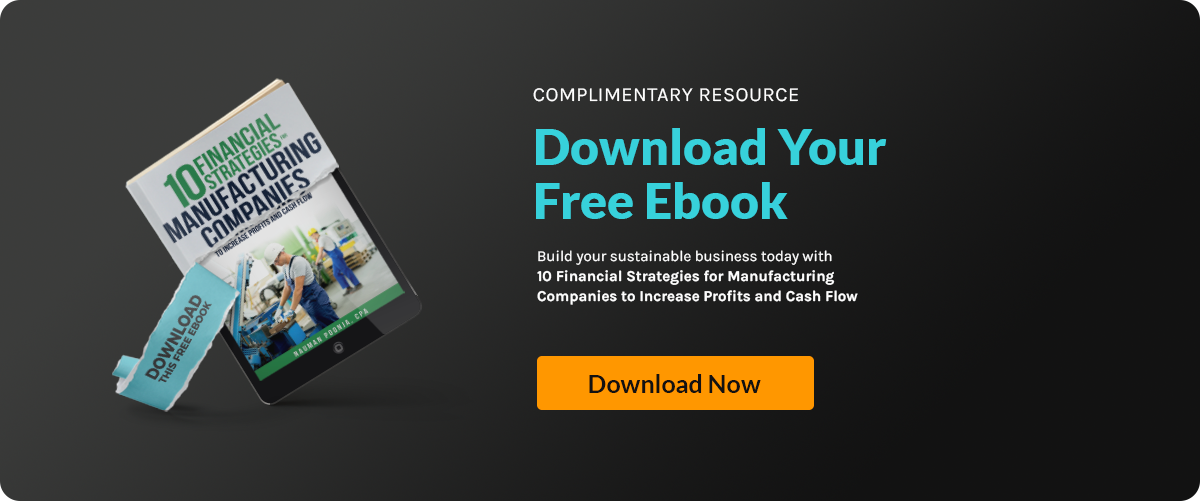Balancing labor costs with operational efficiency is a challenge many manufacturers face. Cutting...
Strategies for Managing Labor Costs in Manufacturing

Labor costs significantly influence profitability and competitiveness in manufacturing. Managing these costs is crucial to maintaining financial health and market competitiveness.
According to the U.S. Bureau of Labor Statistics, labor costs in manufacturing accounted for roughly 20% of total production costs in 2023, highlighting the importance of efficient workforce management.
Manufacturing businesses use various strategies to control these costs, from optimizing workforce schedules to investing in automation. However, unique challenges arise, such as seasonal production fluctuations, skill shortages, and increasing wage demands.
Manufacturers often face questions like, "How can we reduce overtime without sacrificing productivity?" or "Is automation the best solution to lower labor costs?" Finding practical answers is crucial to achieving sustainable growth.
If you're looking for ways to protect your profit margins while maintaining quality and productivity, continue reading to discover how you can implement cost-effective strategies that benefit both your workforce and bottom line.
Understanding Labor Costs and Their Categories
Labor costs encompass all expenses related to compensating employees. This includes not just the salaries and wages paid, but also the costs associated with employee benefits and payroll taxes.
The Value of Knowing Your True Labor Burden Rate
Before making staffing decisions, it’s essential to understand the full cost of employing each team member—not just their base pay. The actual expense, often called the “labor burden rate,” includes wages, but also the less-visible outlays: payroll taxes, health insurance premiums, 401(k) matches, overtime, and other benefits.
Why does this matter? When manufacturers overlook these additional costs, they risk underestimating their actual labor expenditure. For example, hiring what seems like a $20-per-hour employee can quickly add up to a much steeper price tag once benefits and legal obligations are factored in. Without a clear grasp of your labor burden rate, you could unintentionally overspend, or worse, allocate budget to new hires only to discover you’ve stretched resources too thin.
Most importantly, knowing your labor burden rate enables smarter, data-driven decisions. Should you hire full-time staff or increase overtime? How does adding a new benefit affect the bottom line? With a realistic view of all labor-related expenses, you’re better equipped to plan, budget, and adjust workforce strategies as market conditions evolve. This financial clarity not only prevents surprises at year’s end but also helps align your staffing approach with profitability goals and long-term growth.
What Is a Labor Burden Rate?
When evaluating true labor costs, it’s important to look beyond just hourly wages or salaries. The labor burden rate captures the full picture—it’s the total expense a business incurs for employing someone, not just what shows up on the paycheck.
This rate includes base pay, but also factors in employer-paid payroll taxes, workers’ compensation, health insurance, retirement contributions (such as a 401(k) match), and other benefits. It also takes into account costs like paid time off and overtime, which can add up quickly. For instance, while an employee may earn $20 per hour, the real cost to the employer—once you tally all these extras—might be closer to $28 per hour.
How Do You Calculate Labor Burden Rate?
To find an employee’s annual labor burden rate, add up:
- Their annual base pay or total hourly wages,
- All overtime earnings and bonuses,
- Employer contributions to Social Security, Medicare, unemployment insurance, and workers’ compensation,
- Employer-paid benefits (like health insurance and retirement plan matches),
- And any additional perks or mandatory contributions.
The sum of these items gives you the true cost of each employee—a critical figure when making budgeting decisions or exploring ways to streamline your labor costs.
Categories of Labor Costs
Labor costs are typically divided into two main categories:
- Direct Labor Costs: These are expenses directly tied to the production of goods or services. In a manufacturing context, direct labor costs refer to the wages of employees who are actively involved in producing a product. For instance, the salary of a technician on the assembly line falls under this category.
- Indirect Labor Costs: Indirect costs are those not directly linked to production but essential for overall business operations. This includes expenditures such as the salaries of security personnel and administrative staff. These roles, while not involved in the hands-on creation of products, are crucial for maintaining the business infrastructure and supporting the production process.
By understanding these categories, businesses can better analyze their expenses and identify areas for efficient resource allocation.
Managing Labor Costs for Manufacturing Businesses
Managing labor costs for manufacturing businesses involves a strategic approach to balancing cost savings with productivity. Evaluating total labor cost is crucial to effective cost management, considering direct and indirect expenses. This requires analyzing factors like hours worked, overtime rates, and employee benefits. By adopting efficient scheduling practices, manufacturers can reduce unnecessary overtime and optimize staffing levels, resulting in significant cost savings.
Before adding new hires to your team, maximize your current workforce. Hiring is an expensive process, and a “panic hire”—bringing on a poor-fit employee just to fill a gap—often leads to higher turnover and diminished productivity. Instead, consider using temporary overtime for experienced, trusted employees who are already familiar with your operations. When used strategically, overtime can be a cost-effective short-term solution, helping you bridge gaps without the long-term costs associated with onboarding new staff.
Additionally, automation and cross-training employees can improve productivity without thinking solely about reducing headcount. Manufacturers should also make informed decisions about their workforce by regularly reviewing production data and adjusting staffing levels based on demand. Balancing cost control with employee satisfaction ensures an effective labor cost strategy that supports long-term growth.
Adopting an Agile Mindset to Control Labor Costs and Boost Productivity
Embracing an agile approach can play a significant role in controlling labor costs while driving productivity. By focusing on flexibility and continuous improvement, manufacturers can quickly adjust staffing and production processes as business needs evolve—helping to avoid costly overstaffing or wasted resources.
Agile practices encourage teams to break down larger projects into smaller, actionable tasks and foster collaboration between departments. This approach prevents bottlenecks by ensuring the right people are assigned where they're most effective, reducing downtime and minimizing unnecessary labor expenses. For example, agile methodologies—widely used in organizations like Toyota and GE—empower employees at all levels to make decisions, quickly address issues, and implement solutions on the fly.
Ultimately, adopting this mindset supports a culture of adaptability. Teams can respond to changes in demand without the disruption or chaos that can result from rigid planning. This not only helps keep labor costs in check, but also sustains high productivity and employee engagement.
The Role of Cross-Departmental Communication in Cost Efficiency
Effective communication between departments is a cornerstone of efficient labor management in manufacturing. When departments operate in silos or fail to share critical information, it often leads to duplicated efforts, misaligned priorities, and wasted labor hours. For instance, if the production and procurement teams aren’t regularly syncing up, staff might spend unnecessary time correcting orders or rerunning schedules—resulting in needless overtime and avoidable expenses.
Streamlining communication reduces these inefficiencies. Simple practices, such as coordinating via cloud-based project management tools (like Asana or Trello), holding regular interdepartmental meetings, and using shared calendars, help ensure everyone stays on the same page. When teams collaborate seamlessly, businesses can better allocate resources, minimize redundant tasks, and ultimately decrease overall labor costs.
Prioritizing clear and consistent communication not only cuts unnecessary expenditures but also helps maintain a productive, engaged workforce by clarifying roles and reducing frustration over task overlap.
Factors Influencing Job Satisfaction and Employee Retention
Research conducted by Gallup reveals that job satisfaction and employee retention are significantly influenced by several key workplace factors—most notably, the effectiveness of direct managers. Their findings highlight that employees are most satisfied when they feel well-supported, valued, and have clear opportunities for professional growth.
Some of the main drivers include:
- Effective Leadership: Employees with strong, supportive managers who provide clear direction and constructive feedback are more likely to feel engaged and satisfied in their roles.
- Opportunities for Growth: Access to ongoing training, skill development, and realistic career advancement paths contributes significantly to long-term retention.
- Recognition and Fair Compensation: Regular acknowledgment of employee contributions alongside competitive pay signals to employees that their efforts are noticed and appreciated.
- Work-Life Balance: Flexible schedules and an environment that respects personal time foster a positive company culture and reduce turnover.
- Listening to Employees: Collecting employee feedback—and acting on it—demonstrates respect and builds trust, leading to greater loyalty.
By prioritizing these aspects, manufacturers can not only boost employee morale but also minimize costly turnover and create a resilient workforce prepared for growth.
Core Principles of Agile Workflows in Labor Management
Adopting agile workflows is another effective strategy for managing labor costs—particularly when it comes to avoiding overstaffing. Agile methodologies center on flexibility, transparency, and teamwork. Instead of large, rigid workplans, agile emphasizes breaking projects down into smaller, prioritized tasks, allowing teams to adapt quickly to changing production needs.
At the heart of agile workflows are a few key principles:
- Incremental Planning: Projects are divided into smaller milestones, which are reassessed and adjusted regularly. This continuous evaluation means staffing needs can be scaled up or down as demand fluctuates, reducing the risk of excess labor during slow periods.
- Cross-Functional Collaboration: Employees work in multi-skilled teams that can shift focus as priorities change. This versatility allows manufacturers to make the most of their existing workforce, minimizing the need for temporary hires or unnecessary overtime.
- Empowered Teams: Agile encourages front-line workers to make decisions and solve problems proactively. This approach helps businesses react swiftly to production challenges or market shifts, maintaining efficiency without overscheduling staff.
Implementing agile workflows creates a culture of adaptability where resources are allocated based on real-time needs—helping manufacturers align staffing with current demand rather than fixed, outdated schedules.
Rethinking Time-Off Policies to Reduce Labor Costs
Adjusting your company’s time-off policies can have a significant impact on managing labor expenses. Traditional structures that separate vacation, sick, and personal days can be difficult to administer, often leading to unexpected staffing shortages and higher labor costs due to overtime coverage or last-minute temporary hires. Streamlining these policies helps create both administrative efficiency and predictable workforce planning.
One effective strategy is consolidating all paid leave into a single paid time off (PTO) bank, allowing employees more flexibility in how they use their days off while simplifying tracking and management for HR. This can reduce hidden costs associated with unused or excessive leave accruals and lessen end-of-year payout obligations.
Other approaches to consider include:
- Adopting accrual-based time off, so employees earn leave steadily over time, making your cash flow more manageable.
- Setting reasonable limits on how much leave can roll over year-to-year, which decreases the risk of large future payouts.
- Creating blackout periods during peak production months to ensure critical staffing levels are maintained without incurring extra overtime.
Some organizations experiment with unlimited PTO policies, though these are best suited to environments with strong accountability and trust. Ultimately, by reexamining your approach to paid time off and tailoring it to fit your business model, manufacturers can control labor costs while still supporting a satisfied and engaged workforce.
Weighing the Pros and Cons of a Unified PTO Policy
One increasingly popular way to streamline labor costs and enhance employee satisfaction is to bundle vacation, sick, and personal days into a single paid time off (PTO) policy. But is this approach right for your business? Let’s break down the key benefits and potential drawbacks.
Advantages
- Flexibility for Employees: Workers gain more freedom in how they use their days off—whether it's for a vacation, a family emergency, or simply a mental health break. This often leads to increased morale and satisfaction.
- Simplified Administration: HR teams spend less time tracking and differentiating between categories of leave, making payroll processing and policy management more straightforward.
- Predictable Cost Planning: Employers can more easily anticipate and manage annual paid leave expenses, helping avoid unpleasant surprises at year-end.
Potential Downsides
- Risk of Presenteeism: Employees may worry about “using up” all their time, making them less likely to take days off when truly sick. This could lead to more people coming to work ill, impacting overall productivity and health.
- Equity Concerns: Those with greater medical or caregiving needs might use more days for illness, leaving them with less for vacation or personal events.
- Abuse Monitoring Required: With increased flexibility comes the need for clear policies and careful oversight to ensure time off isn’t misused.
Ultimately, a unified PTO approach can support greater employee autonomy and operational efficiency but needs to be tailored to your organizational culture—and paired with clear communication—to realize these benefits while minimizing pitfalls.
Overhead Cost Management and Expense Control
In manufacturing, managing overhead costs is vital to staying competitive and maintaining financial health. Effective overhead cost management and expense control require strategic planning, thorough calculation, and a focus on productivity. Here's a comprehensive guide to reducing labor costs, optimizing staffing levels, and gaining control over your business's profit margins.
1. Optimize Staffing Levels
Ensuring optimal staffing levels is crucial in labor cost management. Too many employees can inflate labor expenses, while too few can reduce productivity. Conduct regular workforce audits to assess current staffing levels and adjust the number of hours each employee works based on production needs. This practice allows businesses to:
- Reduce labor costs by preventing unnecessary overtime.
- Increase productivity by aligning staff schedules with production demand.
When faced with staffing shortages, it can be tempting to rush the hiring process and bring on someone quickly just to fill a gap. However, making what's often called a “panic hire” can lead to several problems down the line.
First, a hasty hire is more likely to result in bringing on an employee who isn’t the right fit for the role or company culture. This mismatch can lead to lower morale, increased mistakes, and ultimately, high turnover rates—which are costly in terms of both time and resources. High turnover often means additional recruiting, onboarding, and training expenses that could have been avoided.
Instead, consider whether temporary solutions—such as offering overtime to experienced and reliable team members—can bridge the gap until the right candidate is found. Strategic use of overtime may be a more cost-effective option in the short term, while you take the necessary time to identify talent that aligns with your long-term goals. This approach not only supports business continuity but also safeguards your investment in human capital.
2. Invest in Employee Training and Development
A well-trained workforce is more efficient, reducing the need for rework and improving productivity. Investing in factors like production or employee training programs helps ensure your team has the skills to maximize production with minimal waste, which can significantly impact labor expenses:
- Cross-train employees to handle multiple roles.
- Promote continuous improvement practices like lean manufacturing.
- Reduce labor costs by eliminating skill gaps and reducing reliance on overtime.
3. Implement Lean Manufacturing Practices
Lean manufacturing practices aim to eliminate waste in business operations, which directly impacts variable labor costs and overhead. Key strategies include:
- Just-in-Time Production: Produce only what is needed when it's required to minimize inventory carrying costs.
- Standardized Work Processes: Develop standardized work processes to reduce variation and improve efficiency.
- Value Stream Mapping: Identify and eliminate non-value-adding activities to reduce labor expense.
4. Strengthen Interdepartmental Communication and Coordination
Enhancing communication and coordination between departments is essential for minimizing wasted labor hours and maximizing operational efficiency. Start by identifying overlapping roles or tasks—such as when separate teams unintentionally duplicate efforts or when information doesn’t flow efficiently across departments.
Implement strategies like:
- Conducting workflow audits to uncover and resolve redundancies or communication gaps.
- Encouraging regular cross-departmental meetings and synchronized updates to keep everyone on the same page.
- Utilizing collaborative tools—such as Slack, Trello, or shared digital calendars—to track projects, share resources, and foster transparent communication.
These practices streamline operations
5. Adopt Automation and Technology
Automation can significantly reduce labor costs by replacing repetitive tasks and improving production efficiency. While initial investment in automation might be high, the long-term benefits often outweigh the costs:
- Automated Machinery: Robotics and automated machinery handle repetitive or dangerous tasks.
- ERP Systems: Implement Enterprise Resource Planning (ERP) systems to calculate labor expenses and optimize resource allocation accurately.
- Production Monitoring Software: Track productivity in real-time to make data-driven decisions.
6. Flexible Staffing Strategies
Fluctuations in demand require flexible staffing strategies to manage variable labor costs effectively. Consider employing:
- Temporary Staff: Hire temporary staff during peak seasons to handle increased demand without inflating long-term labor costs.
- Contract Workers: Utilize contractors for specialized projects or skills not required year-round.
7. Reduce Overtime Costs
Overtime pay can significantly increase labor expenses. Reduce reliance on overtime by:
- Improving Scheduling Efficiency: Use scheduling software to align shifts with production demands.
- Identifying Bottlenecks: Address production bottlenecks to streamline workflows and reduce the need for extended shifts.
- Hiring Part-Time Staff: Employ part-time staff to cover peak production periods.
8. Energy Efficiency Initiatives
Energy costs can form a significant portion of overhead expenses. Implementing energy efficiency initiatives helps reduce overall production costs:
- LED Lighting: Replace conventional lighting with energy-efficient LED lights.
- Equipment Upgrades: Invest in energy-efficient machinery to minimize power consumption.
- Preventive Maintenance: Regular equipment maintenance improves efficiency and reduces downtime.
9. Negotiate with Suppliers
Raw materials and components can represent a substantial portion of overhead costs. Establish strong relationships with suppliers and negotiate favorable terms:
- Bulk Purchasing: Purchase in bulk to leverage economies of scale.
- Long-Term Contracts: Lock in prices through long-term contracts to avoid market fluctuations.
- Supplier Audits: Conduct supplier audits to ensure consistent quality and reduce defective product costs.
10. Outsource Non-Core Activities
Outsourcing non-core activities allows manufacturers to focus on their core competencies while reducing labor and overhead costs:
- Logistics and Distribution: Outsource warehousing and distribution to third-party logistics providers.
- IT Support: Manage IT services instead of maintaining an in-house IT department.
- HR and Payroll: Outsource HR and payroll functions to reduce administrative overhead.
11. Reevaluate Employee Perks for Cost Savings
Employee perks play an important role in attracting and retaining top talent, but not all perks deliver equal value for your workforce—or your bottom line. Regularly reassessing the benefits and incentives on offer can help align spending with what employees truly appreciate, while trimming unnecessary expenses.
Start by surveying your team to identify which perks are genuinely valued. Oftentimes, employees may prefer more flexible or low-cost options, such as remote work opportunities or flexible scheduling, rather than costlier benefits like catered lunches, on-site gyms, or extensive travel stipends.
By streamlining perks to focus on those that matter most, companies can reduce overhead without sacrificing morale or productivity. Additionally, consider making more expensive benefits performance-based or offering scalable alternatives. This approach not only enhances employee satisfaction but also ensures labor costs remain manageable and sustainable as your business grows.
Why Are Labor Costs Increasing in the Manufacturing Sector?
Labor costs in the manufacturing sector are on the rise due to several interconnected factors. A primary driver is the heightened demand for products that manufacturers struggle to meet with current productivity levels.
Increased Demand and Supply Chain Strain
Take, for example, the toilet paper industry during the onset of the pandemic. The surge in consumer demand compelled manufacturers to ramp up production. This push required more raw materials, such as wood pulp, which in turn increased production expenses. These additional costs often result in higher prices for consumers.
Rising Wages and Employee Shortages
Beyond material costs, rising wages are another significant factor. Companies are encountering workforce shortages, prompting them to offer higher salaries to attract and retain employees. This trend is particularly evident as businesses strive to overcome the gap between demand and available labor.
Overall Impact on Labor Costs
The combined effect of increased production needs, escalating raw material prices, and competitive labor market pressures leads to rising labor costs. This multifaceted situation underscores the complex nature of the manufacturing sector's current economic challenges.
In essence, labor costs are increasing as companies adapt to the evolving landscape of consumer demand and workforce dynamics.
Efficiency Improvements for Manufacturing
Manufacturing efficiency improvements are vital to achieving cost efficiency and maintaining control over profit margins. An integrated approach to labor cost management can result in significant labor cost savings by optimizing workforce productivity and efficiency. Tools like production monitoring software and lean manufacturing principles can help manufacturers streamline workflows, reduce waste, and enhance productivity.
Incorporating these improvements into budgeting and financial planning provides a clearer understanding of labor expenses, enabling businesses to make informed adjustments and maintain greater control over their profit margins. Manufacturers can bolster their competitiveness by prioritizing efficiency and achieving long-term financial stability.
Financial Advisory for Labor Cost Reduction
Reducing labor costs is vital for manufacturers to maintain profitability and competitiveness. However, cutting costs without compromising productivity or employee morale requires strategic planning and expert guidance. Financial advisory services can provide invaluable help in understanding labor costs, identifying areas for improvement, and implementing effective strategies. Here's how financial advisors can assist businesses in reducing labor costs while boosting productivity.
Conducting Comprehensive Labor Cost Analysis
Understanding labor costs requires a thorough analysis of direct and indirect expenses, including wages, benefits, and overtime. Financial advisors help create a complete picture of what you're spending on labor by:
- Analyzing Payroll Data: Review salaries, benefits, and overtime to identify opportunities to cut labor costs.
- Benchmarking Industry Standards: Compare labor costs with industry averages to detect inefficiencies.
- Identifying Inefficiencies: Highlight areas of human error or wasteful practices that inflate labor expenses.
Optimizing Staffing Levels and Scheduling
Businesses must optimize staffing levels to align with production demand. Financial advisors can help in:
- Forecasting Demand: Use predictive analytics to anticipate production needs and adjust staffing levels accordingly.
- Reducing Overtime Costs: Implement shift scheduling tools to reduce reliance on overtime while maintaining productivity.
- Cross-Training Employees: Encourage cross-training to maximize workforce flexibility and minimize disruptions.
Enhancing Workforce Productivity
Boosting productivity is a powerful way to cut labor costs without compromising output. Financial advisors can recommend strategies for enhancing workforce productivity, such as:
- Implementing Lean Manufacturing Principles: Reduce waste and streamline workflows to improve efficiency.
- Investing in Automation: Identify tasks suitable for automation to reduce labor-intensive processes.
- Providing Skill Development Training: Equip employees with the skills to perform multiple roles efficiently.
Developing Incentive Programs
Well-structured incentive programs can improve employee morale and productivity. Financial advisors help design programs that balance rewards with cost efficiency:
- Performance-Based Bonuses: Link bonuses to measurable productivity goals.
- Profit-Sharing Plans: Encourage employees to contribute to cost-saving initiatives by sharing company profits.
- Recognition Programs: Acknowledge exceptional performance through non-monetary recognition programs.
Addressing the Cost of Living and Wage Management
Wages must reflect the cost of living while aligning with the company's budget. Financial advisors can provide insights into the following:
- Market-Competitive Salaries: Benchmark salaries against industry standards to attract and retain talent.
- Wage Structuring: Create a wage structure that rewards skill development and performance improvement.
- Benefits Optimization: Adjust employee benefits to balance cost efficiency with employee satisfaction.
Determining Valued Employee Perks
Understanding which perks resonate most with your team is essential for maximizing value while keeping costs in check. Financial advisors often recommend a few practical approaches to gauge employee preferences:
- Conduct Anonymous Surveys: Use tools like Google Forms or SurveyMonkey to gather honest feedback about current and potential perks.
- Hold Focus Groups: Engage small groups of employees in open discussions to explore what benefits make the biggest difference to them.
- Analyze Utilization Data: Review sign-up rates or participation levels for existing perks—such as subsidized transit passes, wellness programs, or remote work options—to see what's genuinely being used.
- Offer Choice-Based Packages: Allow employees to select from a menu of perks, revealing patterns in their selections over time.
This approach helps businesses avoid investing in costly perks that may not matter to staff and instead focus on low-cost, high-impact benefits like flexible scheduling or remote work arrangements.
Utilizing Technology Tools
Technology tools can help streamline labor cost management and improve productivity:
- HR Management Systems: Automate payroll processing, attendance tracking, and benefits management to reduce human error.
- Production Monitoring Software: Monitor production efficiency and identify bottlenecks that affect productivity.
- Shift Scheduling Software: Optimize employee schedules to reduce overtime costs.
Implementing Financial Planning and Budgeting Strategies
Financial advisors play a pivotal role in strategic budgeting and financial planning:
- Budget Allocation: Allocate resources efficiently to various departments based on productivity data.
- Scenario Planning: Prepare for economic changes or market shifts by developing multiple budget scenarios.
- Expense Tracking: Monitor expenses regularly to ensure labor cost reduction strategies are on track.
Optimize Your Manufacturing Operations with Accounovation
At Accounovation, we know that managing direct labor costs effectively is pivotal for business owners in the manufacturing industry. These costs, a substantial part of your business expenses, need precise management to ensure they stay within your bottom line. Our expertise lies in providing precise calculations and strategic insights that directly reduce the costs associated with labor, enhancing your company's efficiency and profitability.
Take control of your manufacturing operations with Accounovation's tailored solutions. We help streamline your processes, ensuring that labor costs are not just expenditures but investments in your business's productivity and growth.
Contact Accounovation to discover how we can assist you in optimizing your operations, reducing costs, and improving your financial performance.







